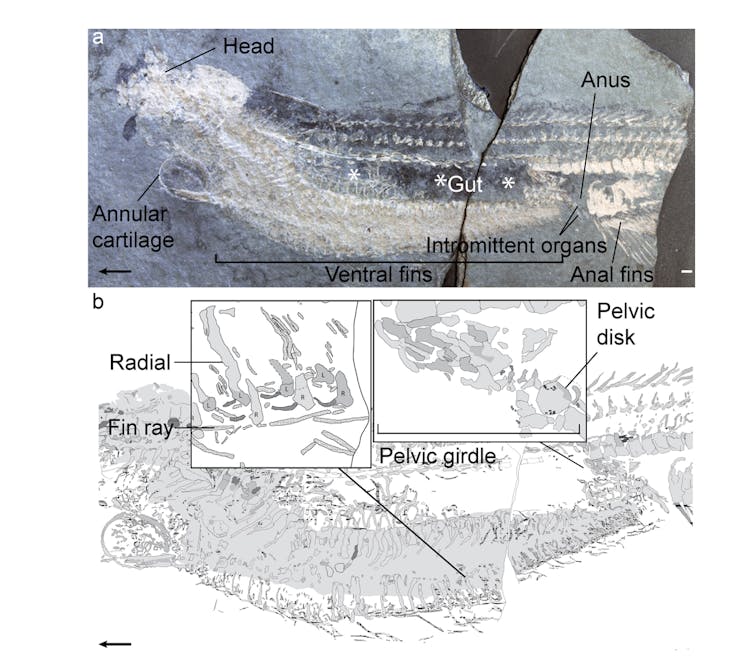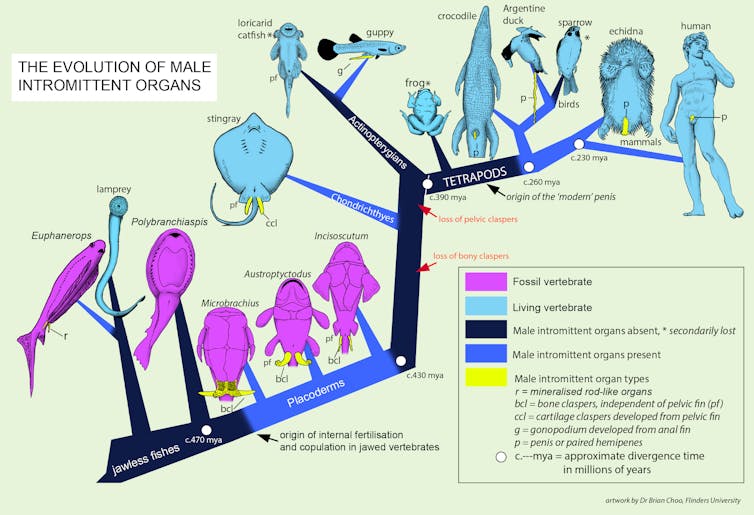a fishy tale much more primitive than we thought
- Written by John Long, Strategic Professor in Palaeontology, Flinders University
Fossil discoveries from the Devonian rocks of Scotland and Australia first revealed that the earliest jawed fishes, the placoderms, reproduced using copulation in much the same way as sharks and rays do today.
They also had the first paired pelvic skeletons, the precursor to the hind paired fins – and legs – of all animals. Their paired reproductive organs, called “claspers”, probably developed in the same way as limbs.
Read more: The first vertebrate sexual organs evolved as an extra pair of legs
The appearance of jaws and teeth in the first vertebrates was thus intimately linked to the origin of paired hind limbs (pelvic girdles) and an advanced kind of sexual reproduction.
Before jaws
But a new discovery from the Miguasha site, in Quebec, eastern Canada, dated at around 380 million years old, rewrites this view of sexual evolution.
Our new paper, published recently in Palaeontology, shows that a Devonian jawless fish, named Euphanerops (pictured top), had paired hind limb structures called pelvic discs and paired slender male reproductive organs.
This is remarkable as these structures, once thought to be unique to jawed fishes (gnathostmes), are now seen to first appear further down the evolutionary tree, in jawless fishes.
This is the first account of such structures in any jawless fish, and suggests that the evolutionary mechanisms necessary for limb and clasper development were in place well before jaws and teeth arose.
Euphanerops is an eel-like fish with simple paired fins along the midline of the body. It was first described from Miguasha in 1900 by Arthur Smith Woodward of the British Museum.
It was originally thought to belong to a group of extinct jawless fishes called anaspids, but this was disputed in recent years. Anaspids were abundant in older Late Silurian and early Devonian times rocks, about 427 million to 400 million years ago.
Our new paper includes a new phylogenetic analysis that also resolves the evolutionary position of Euphanerops as being a true anaspid, showing that the group is monophyletic, or forming a natural clade (or branch in an evolutionary tree). Euphanerops is thus seen to be a late-surviving relict of this once flourishing group.
 Fossil of Euphanerops showing pelvic bone structures and paired sex organs (labelled as ‘intromittent organs’). Scale on top right figure is 1mm.
Marion Chevrinais, Universite du Quebec a Rimouski
Fossil of Euphanerops showing pelvic bone structures and paired sex organs (labelled as ‘intromittent organs’). Scale on top right figure is 1mm.
Marion Chevrinais, Universite du Quebec a Rimouski
Getting some backbone
Most significantly, this fossil jawless fish shows that the backbone has specialised regions that differ from each other, thus the axial skeleton can be said to be regionalised, or specialised into different kinds of vertebral and rib-like bones along its length.
This is the first time such an advanced feature has been identified in any fish without jaws. Very few of these ancient jawless fishes have the internal skeleton well enough preserved to study it properly.
The specimens of Euphanerops are exceptional because they were preserved in fine-grained sediments laid down in an ancient estuary. Each tiny element of its skeleton is clearly preserved.
The high diversity and excellent preservation of fishes and plant fossils found at Miguasha are the reason why this site was designated as a UNESCO World Heritage site in 1999.
Work on the living jawless lamprey, Petromyzon, was then initiated by our team to see if there was any corresponding regionalisation in its skeleton. To our surprise we found that certain variations along the backbone indicated a similar style of regionalisation was also present.
This is significant as the specialised type of backbone land animals have is not usually seen in fishes. Some fossilised ray-finned fishes, such as Tarrasius, show the regionalised spine had evolved by Carboniferous times, but this is an exception, not the regular condition.
 The evolutionary sequence of intromittent sex organs. The new discovery made in Euphanerops pushes back the origin of advanced sexual reproduction using copulation to early jawless fishes.
Brian Choo, Flinders University
The evolutionary sequence of intromittent sex organs. The new discovery made in Euphanerops pushes back the origin of advanced sexual reproduction using copulation to early jawless fishes.
Brian Choo, Flinders University
Old fossils, new finds
The new discovery shows that old fossils of Euphanerops, known for a long time in museum collections, and that had been studied multiple times in the past, could still yield exciting new information when new technological approaches are applied.
The detailed study of the cartilage structure in Euphanerops was critical to identifying skeletal elements (cartilage derived) in the pelvic region, and finding the paired male reproductive organs. The fossils also pointed us to find new information about the axial skeleton in living lampreys.
It seem likely that the next big steps to understanding the early evolution of the first jawed vertebrates will be found by studying more well-preserved early jawless fishes. These kinds of fossils hold the key to when and how more advanced structures found in jawed vertebrates first developed.
Authors: John Long, Strategic Professor in Palaeontology, Flinders University



